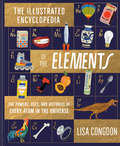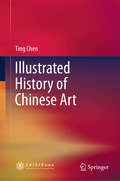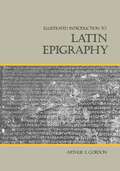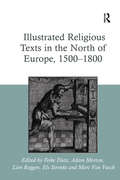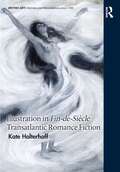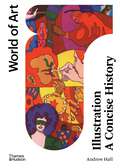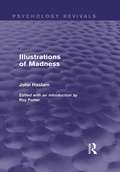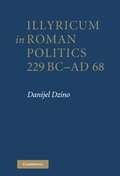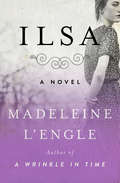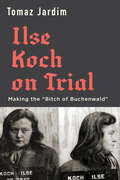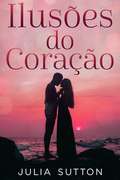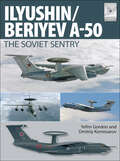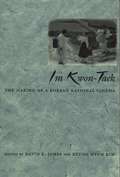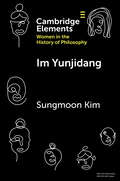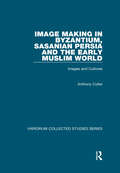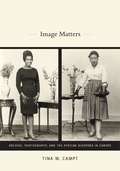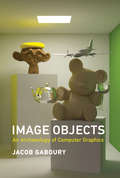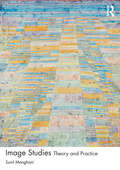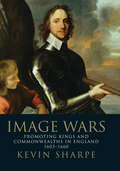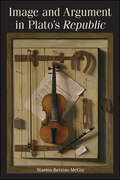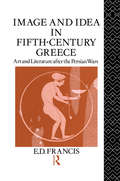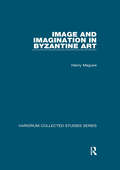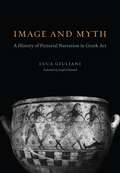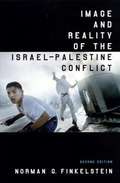- Table View
- List View
Illustrated Encyclopedia of the Elements: The Powers, Uses, And Histories Of Every Atom In The Universe
by Lisa CongdonA gorgeous nonfiction book for kids from bestselling artist and author Lisa Congdon!The Illustrated Encyclopedia of the Elements leads young readers in an exploration of all 118 known elements.From their discoveries to their uses to their special properties, this vibrant book explores all things elements.• A visually stunning tour of the periodic table• Complete with profiles of notable scientists, amazing infographics, and more• Features an illustrated history of the periodic table's originsThis artful survey of the elements combines science, history, trivia, humor, and endless fascination for science enthusiasts of every age.Middle grade readers will delight in this interesting take on the periodic table of elements. • Great for science lovers and Lisa Congdon fans alike• Resonates year-round as a go-to gift for birthdays and holidays for the science-loving kid• Perfect for children ages 10 and up• Equal parts educational and entertaining, this makes a great pick for parents and grandparents, as well as librarians, science teachers, and STEM educators.• You'll love this book if you love books like The Elements Book: A Visual Encyclopedia of the Periodic Table by DK, The Periodic Table by Sean Callery and Miranda Smith, and Elements: A Visual Exploration of Every Known Atom in the Universe by Theodore Gray.
Illustrated History of Chinese Art
by Ting ChenThis book aims to provide readers with a clear and comprehensive picture of the development of Chinese art. Its main feature is the combination of illustration and text. It highlights representative works of art in the form of illustrations and discusses their styles, themes, and underlying artistic principles. In addition, each chapter of the book focuses on covering a specific period in Chinese art history, striving to capture representative artistic and stylistic features of the period and providing a preliminary analysis of the social, political, religious, and cultural factors behind its artistic phenomena.
Illustrated Introduction to Latin Epigraphy
by Arthur E. GordonThis is a much-needed textbook for students of epigraphy and an up-to-date reference work for scholars. Central to the work are its photos. Professor Gordon presents 100 Latin inscriptions arranged in chronological order and illustrated by the best available photographs. The inscriptions, which range in date from the sixth century B.C. to A.D. 525, are collated with standard texts and are accompanied by translations and full annotation. They are preceded by an original introduction dealing with important aspects of Latin epigraphy and followed by several appendices on such special topics as Roman numerals. The photographs of these inscriptions reveal the close relationship between Latin inscriptions and our present-day type fonts by way of the humanistic hand of fifteenth-centry European scholars. This book will be of interest not only to students and scholars of epigraphy but to those interested in the history of typography as well.
Illustrated Religious Texts in the North of Europe, 1500-1800
by Adam Morton Feike Dietz Lien RoggenIn recent years many historians have argued that the Reformation did not - as previously thought - hamper the development of Northern European visual culture, but rather gave new impetus to the production, diffusion and reception of visual materials in both Catholic and Protestant milieus. This book investigates the crosscurrents of exchange in the realm of illustrated religious literature within and beyond confessional and national borders, and against the background of recent insights into the importance of, on the one hand material, as well as on the other hand, sensual and emotional aspects of early modern culture. Each chapter in the volume helps illuminate early modern religious culture from the perspective of the production of illustrated religious texts - to see the book as object, a point at which various vectors of early modern society met. Case studies, together with theoretical contributions, shed light on the ways in which illustrated religious books functioned in evolving societies, by analysing the use, re-use and sharing of illustrated religious texts in England, France, the Low Countries, the German States, and Switzerland. Interpretations based on points of material interaction show us how the most basic binaries of the early modern world - Catholic and Protestant, word and image, public and private - were disrupted and negotiated in the realm of the illustrated religious book. Through this approach, the volume expands the historical appreciation of the place of imagery in post-Reformation Europe.
Illustration in Fin-de-Siècle Transatlantic Romance Fiction (British Art: Histories and Interpretations since 1700)
by Kate HolterhoffThis book examines illustrations created to accompany fictions written by several of the most popular authors published in Britain and America between 1885 and 1920. By studying the lavish illustrations that complemented not only initial serializations, but also subsequent publications of fictions by H. Rider Haggard, Rudyard Kipling, James De Mille, Robert Louis Stevenson, and H. G. Wells, the book demonstrates the significance of images to the fin de siècle romance form. In order to make fantastic plots seem possible, graphic artists worked hand in hand with authors to not only fill gaps in audience understanding, but also expand and deepen the meaning of these marvels. The book will be of interest to scholars working in art history, visual culture, illustration studies, British and American history, and British and American literature.
Illustration: A Concise History (World of Art)
by Andrew HallAn indispensable guide to the international history of illustrated images, from 1750 to the present day. Illustration: A Concise History is a dynamic visual journey through the landscape of illustration that maps the evolution of the discipline from the industrial revolution to the postdigital age and showcases over 180 of its most iconic practitioners, including Laura Knight, Antonio Lopez, Käthe Kollwitz, and Hayao Miyazaki. By contextualizing the subject within a framework of key political events, cultural innovations, and technological advances, Andrew Hall redefines how we might think about illustration and the place that it has in our ever-evolving global network. The second half of this introductory volume follows on from the ten chapters charting the chronology of illustration to provide a more in-depth look at its specific commercial genres across eleven feature sections, each including minihistories, practical career advice, and biographies of inspirational practitioners who operated within the field.
Illustrations of Madness (Psychology Revivals)
by John HaslamJohn Haslam’s Illustrations of Madness, written in 1810, occupies a special place in psychiatric history, it was the first book-length account of one single psychiatric case written by a British psychiatrist. John Haslam, apothecary to London’s Bethlem Hospital, and a leading psychiatrist of the early-nineteenth century, details the case of James Tilly Matthews, who had been a patient in the hospital for some ten years. Matthews claimed he was sane, as did his friends and certain doctors. Haslam, on behalf of the Bethlem authorities, contended he was insane, and attempted to demonstrate this by presenting a detailed account of Matthew’s own delusional system, as far as possible in Matthew’s own words. Originally published in 1988 as part of the Tavistock Classics in the History of Psychiatry series, Roy Porter’s Introduction to this facsimile reprint of an historic book goes beyond Haslam’s text to reveal the extraordinary psychiatric politics surrounding Matthew’s confinement and the court case it produced, leading up to Haslam’s dismissal from his post. Still relevant today, Haslam’s account can be used as material upon which to base a modern diagnosis of Matthew’s disorder.
Illyricum in Roman Politics 229 BC-AD 68
by Danijel DzinoIllyricum, in the western Balkan peninsula, was a strategically important area of the Roman Empire where the process of Roman imperialism began early and lasted for several centuries. Dzino here examines Roman political conduct in Illyricum; the development of Illyricum in Roman political discourse; and the beginning of the process that would integrate Illyricum into the Roman Empire and wider networks of the Mediterranean world. In addition, he also explores the different narrative histories, from the romanocentric narrative of power and Roman military conquest, which dominate the available sources, to other, earlier scholarly interpretations of events.
Ilsa: A Novel
by Madeleine L'EngleLong out of print, the second novel by the bestselling author of A Wrinkle in Time looks at the darker side of love in a Southern town. From the moment Henry Porcher first sees Ilsa Brandes, he worships her. Despite controversy surrounding the young girl, Henry is drawn to her, a fascination that turns into a lifelong infatuation. As the years pass, Ilsa&’s memory never leaves him, not until the day he returns to their sleepy Southern hometown and renews their childhood friendship. Henry watches as she becomes a wife, then a mother, then a widow, irrevocably changed by tragedy. Out of print for nearly six decades, this rare and sought-after novel is a portrait of a remarkable woman bound by both the stifling conventions of her time and place, and her own sense of honor and purpose. A departure from L&’Engle&’s later works, Ilsa is a dark, intriguing novel about passion, fixation, and the real price of unrequited love by an author renowned for her children&’s classics as well as her candid personal memoirs. This ebook features an illustrated biography of Madeleine L&’Engle including rare images from the author&’s estate.
Ilse Koch on Trial: Making the “Bitch of Buchenwald”
by Tomaz JardimAn authoritative reassessment of one of the Third Reich’s most notorious war criminals, whose alleged sexual barbarism made her a convenient scapegoat and obscured the true nature of Nazi terror.On September 1, 1967, one of the Third Reich’s most infamous figures hanged herself in her cell after nearly twenty-four years in prison. Known as the “Bitch of Buchenwald,” Ilse Koch was singularly notorious, having been accused of owning lampshades fabricated from skins of murdered camp inmates and engaging in “bestial” sexual behavior. These allegations fueled a public fascination that turned Koch into a household name and the foremost symbol of Nazi savagery. Her subsequent prosecution resulted in a scandal that prompted US Senate hearings and even the intervention of President Truman.Yet the most sensational atrocities attributed to Koch were apocryphal or unproven. In this authoritative reappraisal, Tomaz Jardim shows that, while Koch was guilty of heinous crimes, she also became a scapegoat for postwar Germans eager to distance themselves from the Nazi past. The popular condemnation of Koch—and the particularly perverse crimes attributed to her by prosecutors, the media, and the public at large—diverted attention from the far more consequential but less sensational complicity of millions of ordinary Germans in the Third Reich’s crimes.Ilse Koch on Trial reveals how gendered perceptions of violence and culpability drove Koch’s zealous prosecution at a time when male Nazi perpetrators responsible for greater crimes often escaped punishment or received lighter sentences. Both in the international press and during her three criminal trials, Koch was condemned for her violation of accepted gender norms and “good womanly behavior.” Koch’s “sexual barbarism,” though treated as an emblem of the Third Reich’s depravity, ultimately obscured the bureaucratized terror of the Nazi state and hampered understanding of the Holocaust.
Ilusões do Coração
by Julia SuttonO primeiro ano na Universidade Chattlesbury está chegando ao fim. Cinco estudantes tornaram-se amigos e suas vidas estão progredindo tanto academicamente quanto pessoalmente. Forçado a amadurecer cedo demais, a vida de Will pode ser a mesma novamente? Prejudicada pela perda pessoal, Evelyn pode superar sua dor? Segredos e revelações ameaçam destruir o mundo que Sophie conhece. O crescente amor de Juliette por um homem pode superar a oposição daqueles ao seu redor? Ann está se esforçando para conseguir a única coisa que vai conseguir preenchê-la. Vida e sonhos colidem em “Ilusões do Coração”, com cinco personagens enfrentando novos desafios. É uma estória edificante de otimismo, amor, perda e tenacidade do espírito humano.
Ilyushin/Beriyev A-50: The 'Soviet Sentry' (FlightCraft)
by Yefim Gordon Dmitriy KomissarovBrought out in the late 1970s as a successor to the obsolete Tu-126 airborne early warning aircraft, the A-50 co-developed by the Il'yushin and Beriyev bureaux is one of the most interesting military variants in the field of IL-76 military transport. Differing outwardly from the latter mainly in having a conventional saucer rotodome, the A-50 entered flight testing in 1980; the new Soviet AWACS entered service four years later. The improved A-50M was developed several years after that. The type continues in service with the Russian Air Force today, and the fleet is being upgraded to A-50U standard. This book describes the A-50's thrilling developmental history, taking in its many variants (including the A-50EI export model for India) and gives an extensive overview of the various scale model kits covering the subject currently available on the market.
Im Kwon-Taek: The Making of a Korean National Cinema
by Kyung Hyun Kim David E. JamesKorean cinema was virtually unavailable to the West during the Japanese colonial period (1910-1945), and no film made before 1943 has been recovered even though Korea had an active film-making industry that produced at least 240 films. For a period of forty years, after Korea was liberated from colonialism, a time where Western imports were scarce, Korean cinema became an innovative force reflecting a society whose social and cultural norms were becoming less conservative. Im Kwon-Taek: The Making of a Korean National Cinema is a colleciton of essays written about Im Kwon-Taek, better know as the father of New Korean Cinema, that takes a critical look at the situations of filmmakers in South Korea. Written by leading Koreanists and scholars of Korean film in the United States, Im Kwon-Taek is the first scholarly treatment of Korean cinema. It establishes Im Kwon-Taek as the only major Korean director whose life's work covers the entire history of South Korea's military rule (1961-1992). It demonstrates Im's struggles with Korean cinema's historical contradictions and also shows how Im rose above political discord. The book includes an interview with Im, a chronology of Korean cinema and Korean history showing major dynastic periods and historical and political events, and a complete filmography. Im Kwon-Taek is timely and makes a significant contribution to our understanding of Korean cinema. These essays situate Im Kwon-Taek within Korean filmmaking, placing him in industrial, creative, and social contexts, and closely examine some of his finest films. Im Kwon-Taek will interest students and scholars of film studies, Korean studies, religious studies, postcolonial studies, and Asian studies.
Im Yunjidang (Elements on Women in the History of Philosophy)
by Sungmoon KimThis Element aims to critically examine the philosophical thought of Im Yunjidang 任允摯堂 (1721–93), a female Korean Neo-Confucian philosopher from the Chosŏn 朝鮮 dynasty (1392–1910), and to present her as a feminist thinker. Unlike most Korean women of her time, Yunjidang had the exceptional opportunity to be introduced to a major philosophical debate among Korean Neo-Confucians, which was focused on two core questions-whether sages and commoners share the same heart-mind, and whether the natures of human beings and animals are identical. In the course of engaging in this debate, she was able to reformulate Neo-Confucian metaphysics and ethics of moral self-cultivation, culminating in her bold ideas of the moral equality between men and women and the possibility of female sagehood. By proposing a 'stage-approach' to feminism that is also sensitive to the cultural context, this Element shows that Yunjidang's philosophical thought could be best captured in terms of Confucian feminism.
Image Making in Byzantium, Sasanian Persia and the Early Muslim World: Images and Cultures (Variorum Collected Studies #905)
by Anthony CutlerRelations between Byzantium and its neighbours are the focus of this volume. The papers address questions of cultural exchange, with special attention to art historical relations as shown by technical, iconographic and diplomatic exchanges. While addressed to specialists, both their approach and the language make these papers accessible to students at all levels.
Image Matters: Archive, Photography, and the African Diaspora in Europe
by Tina M. CamptIn Image Matters, Tina M. Campt traces the emergence of a black European subject by examining how specific black European communities used family photography to create forms of identification and community. At the heart of Campt's study are two photographic archives, one composed primarily of snapshots of black German families taken between 1900 and 1945, and the other assembled from studio portraits of West Indian migrants to Birmingham, England, taken between 1948 and 1960. Campt shows how these photographs conveyed profound aspirations to forms of national and cultural belonging. In the process, she engages a host of contemporary issues, including the recoverability of non-stereotypical life stories of black people, especially in Europe, and their impact on our understanding of difference within diaspora; the relevance and theoretical approachability of domestic, vernacular photography; and the relationship between affect and photography. Campt places special emphasis on the tactile and sonic registers of family photographs, and she uses them to read the complexity of "race" in visual signs and to highlight the inseparability of gender and sexuality from any analysis of race and class. Image Matters is an extraordinary reflection on what vernacular photography enabled black Europeans to say about themselves and their communities.
Image Objects: An Archaeology of Computer Graphics
by Jacob GabouryHow computer graphics transformed the computer from a calculating machine into an interactive medium, as seen through the histories of five technical objects.Most of us think of computer graphics as a relatively recent invention, enabling the spectacular visual effects and lifelike simulations we see in current films, television shows, and digital games. In fact, computer graphics have been around as long as the modern computer itself, and played a fundamental role in the development of our contemporary culture of computing. In Image Objects, Jacob Gaboury offers a prehistory of computer graphics through an examination of five technical objects--an algorithm, an interface, an object standard, a programming paradigm, and a hardware platform--arguing that computer graphics transformed the computer from a calculating machine into an interactive medium. Gaboury explores early efforts to produce an algorithmic solution for the calculation of object visibility; considers the history of the computer screen and the random-access memory that first made interactive images possible; examines the standardization of graphical objects through the Utah teapot, the most famous graphical model in the history of the field; reviews the graphical origins of the object-oriented programming paradigm; and, finally, considers the development of the graphics processing unit as the catalyst that enabled an explosion in graphical computing at the end of the twentieth century. The development of computer graphics, Gaboury argues, signals a change not only in the way we make images but also in the way we mediate our world through the computer--and how we have come to reimagine that world as computational.
Image Studies: Theory and Practice
by Sunil ManghaniImage Studies offers an engaging introduction to visual and image studies. In order to better understand images and visual culture the book seeks to bridge between theory and practice; asking the reader to think critically about images and image practices, but also simultaneously to make images and engage with image-makers and image-making processes. Looking across a range of domains and disciplines, we find the image is never a single, static thing. Rather, the image can be a concept, an object, a picture, or medium – and all these things combined. At the heart of this book is the idea of an ‘ecology of images’, through which we can examine the full ‘life’ of an image – to understand how an image resonates within a complex set of contexts, processes and uses. Part 1 covers theoretical perspectives on the image, supplemented with practical entries on making, researching and writing with images. Part 2 explores specific image practices and cultures, with chapters on drawing and painting; photography; visual culture; scientific imaging; and informational images. A wide range of illustrations complement the text throughout and each chapter includes creative tasks, keywords (linked to an online resource), summaries and suggested further reading. In addition, each of the main chapters include selected readings by notable authors across a range of subject areas, including: Art History, Business, Cognitive Science, Communication Studies, Infographics, Neuroscience, Photography, Physics, Science Studies, Social Semiotics, Statistics, and Visual Culture.
Image Wars: Kings and Commonwealths in England, 1603-1660
by Kevin SharpeSpin and photo opportunities may appear to have emerged onto the political scene only recently, but in fact image and its manipulation have always been vital to the authority of rulers. This book, the second in Kevin Sharpe's trilogy exploring image, power, and communication in early modern England, examines its importance during the turbulent seventeenth century. From the coronation of James I to the end of Cromwell's protectorate, Sharpe considers how royalists and parliamentarians--often using the same vocabularies--sought to manage their public image through words, pictures, and performances in order to win support and secure and enhance their authority.
Image and Argument in Plato's Republic (SUNY series in Ancient Greek Philosophy)
by Marina Berzins McCoyAlthough Plato has long been known as a critic of imagination and its limits, Marina Berzins McCoy explores the extent to which images also play an important, positive role in Plato's philosophical argumentation. She begins by examining the poetic educational context in which Plato is writing and then moves on to the main lines of argument and how they depend upon a variety of uses of the imagination, including paradigms, analogies, models, and myths. McCoy takes up the paradoxical nature of such key metaphysical images as the divided line and cave: on the one hand, the cave and divided line explicitly state problems with images and the visible realm. On the other hand, they are themselves images designed to draw the reader to greater intellectual understanding. The author gives a perspectival reading, arguing that the human being is always situated in between the transcendence of being and the limits of human perspective. Images can enhance our capacity to see intellectually as well as to reimagine ourselves vis-à-vis the timeless and eternal. Engaging with a wide range of continental, dramatic, and Anglo-American scholarship on images in Plato, McCoy examines the treatment of comedy, degenerate regimes, the nature of mimesis, the myth of Er, and the nature of Platonic dialogue itself.
Image and Idea in Fifth Century Greece: Art and Literature After the Persian Wars
by E. D. FrancisFirst published in 1990. Routledge is an imprint of Taylor & Francis, an informa company.
Image and Imagination in Byzantine Art (Variorum Collected Studies #866)
by Henry MaguireThe twelve studies contained in this second collection by Henry Maguire are linked together by a common theme, namely the relationship of Byzantine art to the imaginary. They show how art enabled the Byzantines not only to imagine the sacred events of the past, but also to visualize the invisible present by manifesting the spiritual world that they could not see. The articles are grouped around the following five topics: the depiction of nature by the Byzantines before and after iconoclasm, especially in portrayals of the earthly and the spiritual Paradise; the social functions and theological significance of classical artistic forms in Byzantine art after iconoclasm; the association between rhetoric and the visual arts in Byzantium, especially in contrast to the role played by liturgical drama in western medieval art; the relationship of the visual arts to Byzantine concepts of justice and the law, both human and divine; and portrayals of the two Byzantine courts, the imperial court on earth and the imagined court in heaven. The papers cover a wide range of media, including floor and wall mosaics, paintings in manuscripts and churches, ivory carvings, coins, and enamel work.
Image and Myth: A History of Pictorial Narration in Greek Art
by Luca Giuliani translated by Joseph O'DonnellOn museum visits, we pass by beautiful, well-preserved vases from ancient Greece but how often do we understand what the images on them depict? In "Image and Myth," Luca Giuliani tells the stories behind the pictures, exploring how artists of antiquity had to determine which motifs or historical and mythic events to use to tell an underlying story while also keeping in mind the tastes and expectations of paying clients. Covering the range of Greek style and its growth between the early Archaic and Hellenistic periods, Giuliani describes the intellectual, social, and artistic contexts in which the images were created. He reveals that developments in Greek vase painting were driven as much by the times as they were by tradition the better-known the story, the less leeway the artists had in interpreting it. As literary culture transformed from an oral tradition, in which stories were always in flux, to the stability of written texts, the images produced by artists eventually became nothing more than illustrations of canonical works. At once a work of cultural and art history, "Image and Myth" builds a new way of understanding the visual culture of ancient Greece. "
Image and Myth: A History of Pictorial Narration in Greek Art
by Luca GiulianiOn museum visits, we pass by beautiful, well-preserved vases from ancient Greece—but how often do we understand what the images on them depict? In Image and Myth, Luca Giuliani tells the stories behind the pictures, exploring how artists of antiquity had to determine which motifs or historical and mythic events to use to tell an underlying story while also keeping in mind the tastes and expectations of paying clients. Covering the range of Greek style and its growth between the early Archaic and Hellenistic periods, Giuliani describes the intellectual, social, and artistic contexts in which the images were created. He reveals that developments in Greek vase painting were driven as much by the times as they were by tradition—the better-known the story, the less leeway the artists had in interpreting it. As literary culture transformed from an oral tradition, in which stories were always in flux, to the stability of written texts, the images produced by artists eventually became nothing more than illustrations of canonical works. At once a work of cultural and art history, Image and Myth builds a new way of understanding the visual culture of ancient Greece.
Image and Reality of the Israel Palestine Conflict (2nd edition)
by Norman G. FinkelsteinFirst published in 1995, this polemical study challenges generally accepted truths of the Israel-Palestine conflict as well as much of the revisionist literature. This new edition critically re-examines dominant popular and scholarly images in the light of the current failures of the peace process.
